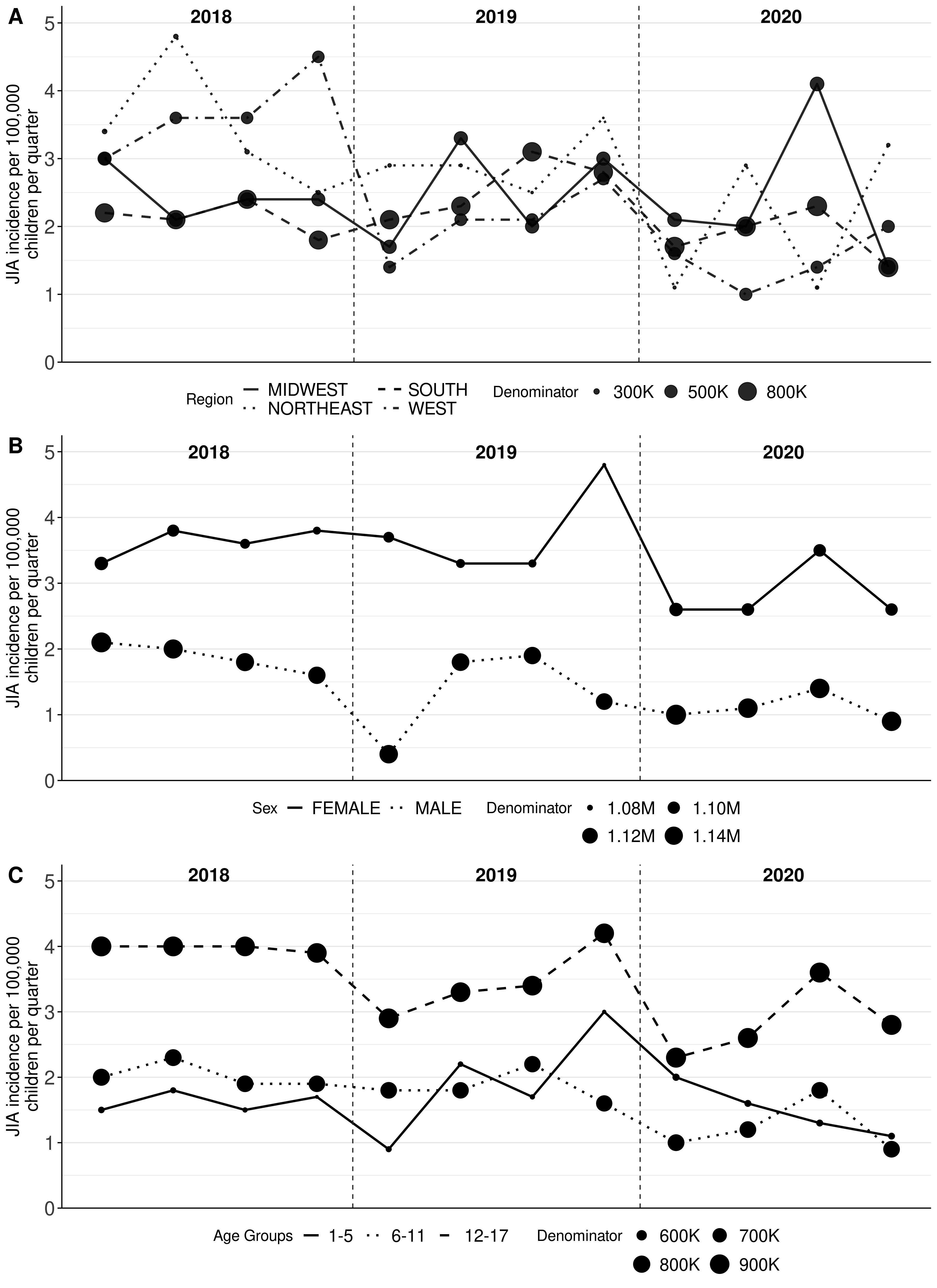Back
Ignite Talk
Session: Ignite Session 6A
0861: Incidence of Juvenile Idiopathic Arthritis During the COVID-19 Pandemic: An Analysis of National United States Administrative Claims Data
Sunday, November 13, 2022
2:15 PM – 2:20 PM Eastern Time
Location: Northern Liberties Stage

Daniel Horton, MD, MS
Rutgers Robert Wood Johnson Medical School
New Brunswick, NJ, United StatesDisclosure: Disclosure information not submitted.
Ignite Speaker(s)
Daniel Horton1, Amanda Neikirk2, Yiling Yang2, Cecilia Huang3, Stephen Crystal4, amy davidow5, Kevin Haynes6, Tobias Gerhard7, Carlos Rose8, Brian Strom9 and Lauren Parlett2, 1Rutgers Robert Wood Johnson Medical School, New Brunswick, NJ, 2HealthCore, Wilmington, DE, 3Rutgers Center for Pharmacoepidemiology and Treatment Science, New Brunswick, NJ, 4Rutgers Center for Health Services Research, New Brunswick, NJ, 5New York University, New York, NY, 6Johnson & Johnson, Titusville, NJ, 7Ernest Mario School of Pharmacy, Rutgers University, New Brunswick, NJ, 8Nemours, Chadds Ford, PA, 9Rutgers Biomedical and Health Sciences, Newark, NJ
Background/Purpose: Limited information exists on how rates of diagnosis of rheumatic diseases have changed during the COVID-19 pandemic. We compared rates of JIA diagnosis before and during the first year of the US pandemic among commercially insured children.
Methods: Using national commercial health plan data (2016-2021), we identified children under 18 years old with ≥12 months of baseline continuous enrollment without JIA diagnosis or treatment. Incident JIA diagnoses were identified using a combination of ICD-10-CM diagnosis codes (L40.5, M05, M06, M08, or M45) and location and timing of medical services, namely, ≥1 inpatient hospitalization, ≥2 outpatient visits ≥8 weeks apart, or ≥1 outpatient visit PLUS dispensing of JIA medications (NSAID, intra-articular glucocorticoid, oral glucocorticoid or DMARD) within 1 month. Quarters were 90 days in length and anchored on March 1, 2020 (start 2020 Q1). Crude rates (95% confidence intervals (CIs)) of JIA diagnosis per 100,000 enrolled children per quarter 2018-2021 were estimated. Differences based on US region, sex, and age group were explored based on stratified analyses. The incidence rate ratio (95%CI) for JIA diagnosis in the pandemic (Mar 2020-Feb 2021) versus pre-pandemic periods (Mar 2017-Feb 2020) was estimated using Poisson regression, adjusted for age, sex, region, quarter, and census tract-based socioeconomic status using offsets of the log of enrollees per quarter.
Results: A total of 643 children were diagnosed with JIA during the study period (Table). Crude incident diagnosis rates of JIA dropped from 2.8 per 100,000 children per quarter (95% CI 2.6, 3.0) before the pandemic to 2.0 (95% CI 1.5, 2.4) during the pandemic. Diagnosis rates during the pandemic were lower in Q1 and Q2 and rose in Q3 (coinciding with a national US nadir in COVID-19-associated hospitalizations) before falling again in Q4 (during a subsequent COVID-19 wave in the US) (Figure 1). Declines in JIA diagnosis were more apparent in the US Northeast and West and among older children (Figure 2). After adjustment for covariates, JIA diagnoses fell by 30% during the pandemic compared to the prior 3 years (IRR 0.70, 95% CI 0.59-0.83).
Conclusion: Compared with the pre-pandemic period, JIA was diagnosed 30% less often during the first year of the pandemic among commercially insured children in the US. The rebound in diagnosis rates in the fall of 2020 and the heterogeneity across US regions suggest that these declines were due at least partly to pandemic-related changes in healthcare utilization and access to care. More research is needed to understand the underlying reasons for the observed changes in JIA diagnosis, whether all types of JIA were affected similarly, and whether pandemic-related delays in diagnosis led to worse outcomes at a population level.
.jpg) Table. Characteristics of US commercially insured children diagnosed with JIA pre-pandemic (Mar 2017-Feb 2020) and during the pandemic (Mar 2020-Feb 2021). Socioeconomic status quartile was based on census tract data from the American Community Survey (2013-2017).
Table. Characteristics of US commercially insured children diagnosed with JIA pre-pandemic (Mar 2017-Feb 2020) and during the pandemic (Mar 2020-Feb 2021). Socioeconomic status quartile was based on census tract data from the American Community Survey (2013-2017).
.jpg) Figure 1. Quarterly rates of JIA diagnosis before and during the pandemic.
Figure 1. Quarterly rates of JIA diagnosis before and during the pandemic.
Crude rates (markers) with 95% confidence intervals (bars) were estimated for new JIA diagnoses per 100,000 enrolled children per quarter, Mar 2018-Feb 2021. The pre-pandemic and pandemic periods are shown separated by a vertical dashed line.
 Figure 2. Quarterly rates of JIA diagnosis before and during the pandemic, stratified by region, sex, and age group.
Figure 2. Quarterly rates of JIA diagnosis before and during the pandemic, stratified by region, sex, and age group.
Crude rates were estimated for new JIA diagnoses per 100,000 enrolled children per quarter, Mar 2018-Feb 2021, stratified by region (A), sex (B), and age group (C). Marker sizes are proportional to the sizes of the respective subpopulations.
Disclosures: D. Horton, Danisco USA Inc., Childhood Arthritis and Rheumatology Research Alliance, American College of Rheumatology; A. Neikirk, None; Y. Yang, None; C. Huang, None; S. Crystal, None; a. davidow, None; K. Haynes, Janssen, Anthem; T. Gerhard, None; C. Rose, None; B. Strom, Lundbeck NA, Abbvie, Consumer Healthcare Products Association; L. Parlett, Sanofi.
Background/Purpose: Limited information exists on how rates of diagnosis of rheumatic diseases have changed during the COVID-19 pandemic. We compared rates of JIA diagnosis before and during the first year of the US pandemic among commercially insured children.
Methods: Using national commercial health plan data (2016-2021), we identified children under 18 years old with ≥12 months of baseline continuous enrollment without JIA diagnosis or treatment. Incident JIA diagnoses were identified using a combination of ICD-10-CM diagnosis codes (L40.5, M05, M06, M08, or M45) and location and timing of medical services, namely, ≥1 inpatient hospitalization, ≥2 outpatient visits ≥8 weeks apart, or ≥1 outpatient visit PLUS dispensing of JIA medications (NSAID, intra-articular glucocorticoid, oral glucocorticoid or DMARD) within 1 month. Quarters were 90 days in length and anchored on March 1, 2020 (start 2020 Q1). Crude rates (95% confidence intervals (CIs)) of JIA diagnosis per 100,000 enrolled children per quarter 2018-2021 were estimated. Differences based on US region, sex, and age group were explored based on stratified analyses. The incidence rate ratio (95%CI) for JIA diagnosis in the pandemic (Mar 2020-Feb 2021) versus pre-pandemic periods (Mar 2017-Feb 2020) was estimated using Poisson regression, adjusted for age, sex, region, quarter, and census tract-based socioeconomic status using offsets of the log of enrollees per quarter.
Results: A total of 643 children were diagnosed with JIA during the study period (Table). Crude incident diagnosis rates of JIA dropped from 2.8 per 100,000 children per quarter (95% CI 2.6, 3.0) before the pandemic to 2.0 (95% CI 1.5, 2.4) during the pandemic. Diagnosis rates during the pandemic were lower in Q1 and Q2 and rose in Q3 (coinciding with a national US nadir in COVID-19-associated hospitalizations) before falling again in Q4 (during a subsequent COVID-19 wave in the US) (Figure 1). Declines in JIA diagnosis were more apparent in the US Northeast and West and among older children (Figure 2). After adjustment for covariates, JIA diagnoses fell by 30% during the pandemic compared to the prior 3 years (IRR 0.70, 95% CI 0.59-0.83).
Conclusion: Compared with the pre-pandemic period, JIA was diagnosed 30% less often during the first year of the pandemic among commercially insured children in the US. The rebound in diagnosis rates in the fall of 2020 and the heterogeneity across US regions suggest that these declines were due at least partly to pandemic-related changes in healthcare utilization and access to care. More research is needed to understand the underlying reasons for the observed changes in JIA diagnosis, whether all types of JIA were affected similarly, and whether pandemic-related delays in diagnosis led to worse outcomes at a population level.
.jpg) Table. Characteristics of US commercially insured children diagnosed with JIA pre-pandemic (Mar 2017-Feb 2020) and during the pandemic (Mar 2020-Feb 2021). Socioeconomic status quartile was based on census tract data from the American Community Survey (2013-2017).
Table. Characteristics of US commercially insured children diagnosed with JIA pre-pandemic (Mar 2017-Feb 2020) and during the pandemic (Mar 2020-Feb 2021). Socioeconomic status quartile was based on census tract data from the American Community Survey (2013-2017)..jpg) Figure 1. Quarterly rates of JIA diagnosis before and during the pandemic.
Figure 1. Quarterly rates of JIA diagnosis before and during the pandemic. Crude rates (markers) with 95% confidence intervals (bars) were estimated for new JIA diagnoses per 100,000 enrolled children per quarter, Mar 2018-Feb 2021. The pre-pandemic and pandemic periods are shown separated by a vertical dashed line.
 Figure 2. Quarterly rates of JIA diagnosis before and during the pandemic, stratified by region, sex, and age group.
Figure 2. Quarterly rates of JIA diagnosis before and during the pandemic, stratified by region, sex, and age group. Crude rates were estimated for new JIA diagnoses per 100,000 enrolled children per quarter, Mar 2018-Feb 2021, stratified by region (A), sex (B), and age group (C). Marker sizes are proportional to the sizes of the respective subpopulations.
Disclosures: D. Horton, Danisco USA Inc., Childhood Arthritis and Rheumatology Research Alliance, American College of Rheumatology; A. Neikirk, None; Y. Yang, None; C. Huang, None; S. Crystal, None; a. davidow, None; K. Haynes, Janssen, Anthem; T. Gerhard, None; C. Rose, None; B. Strom, Lundbeck NA, Abbvie, Consumer Healthcare Products Association; L. Parlett, Sanofi.

